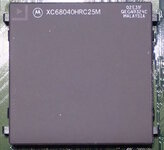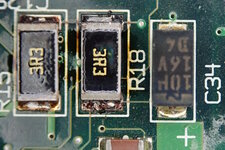David Cook
Well-known member
I just picked up a Centris 650. There isn't enough notable to start a new thread, so I'll just piggyback here.
The CPU an HRC variant, which is interesting. (The factory heatsink and solder paste was removed prior to photographing.)

Upon powering up, the computer emitted *most* of the happy boot chime followed by a 'clipping' and distorted end to the chime. After that the computer did not show video nor did it make a sad Mac sound. About 10 seconds later, a burning component smell filled the air. Removing the cover did not show any damage. Rebooting with a Flir infrared camera targeted the following location. The camera was unnecessary, as smoke appeared at power up around these parts. Can you guess what's wrong?

Capacitor C34 is a factory tantalum. Yet, apparently waking up from such a long slumber killed it. It doesn't appear burned or burst, because it failed only 'mostly short'. There's a big difference between 'mostly short' and 'all short'. It measures about 16 ohm in resistance.
Replacing the capacitor fixed the problem and the computer starts up and passes all the tests. I'm surprised that the amount of current present to emit smoke and internally burn a component did not damage the nearby traces.
The CPU an HRC variant, which is interesting. (The factory heatsink and solder paste was removed prior to photographing.)

Upon powering up, the computer emitted *most* of the happy boot chime followed by a 'clipping' and distorted end to the chime. After that the computer did not show video nor did it make a sad Mac sound. About 10 seconds later, a burning component smell filled the air. Removing the cover did not show any damage. Rebooting with a Flir infrared camera targeted the following location. The camera was unnecessary, as smoke appeared at power up around these parts. Can you guess what's wrong?

Capacitor C34 is a factory tantalum. Yet, apparently waking up from such a long slumber killed it. It doesn't appear burned or burst, because it failed only 'mostly short'. There's a big difference between 'mostly short' and 'all short'. It measures about 16 ohm in resistance.
Replacing the capacitor fixed the problem and the computer starts up and passes all the tests. I'm surprised that the amount of current present to emit smoke and internally burn a component did not damage the nearby traces.
